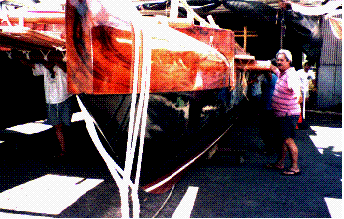 |
|
The Building of Hawai'iloa [Photo below: Hawai'iloa]
One of the first problems in carrying out the plan to construct the canoe out of native materials was the discovery that the forests of Hawai'i did not contain koa trees large enough for the hulls of a voyaging canoe. A search for logs in 1989-1990 was unsuccessful, for over the years, the koa forests have been ruined by forestry and cattle grazing. (For information about the current condition of Hawai'i's native forests and trees, and Hawai'i forestry, see "Hawai'i's Forestry Website".) The search took the builders to Alaska. When told about the unsuccessful search for logs, the SeAlaska Corporation (owned by the Tlingit, Haida, and Tshimshiam tribes of Southeast Alaska), offered to donate two Sitka spruce logs. Byron Maillot, the CEO of SeAlaska, explained the connection between the native peoples of Hawai'i and Alaska: "Both the reality and the symbolism of the [Hawai'iloa] project breathe hope and inspiration into all peoples seeking to maintain their traditions, heritage and culture in a society that does not place a high priority on such things except when they may touch a nerve or help nurture shared values through an expression of such vision, initiative and sheer innate beauty that all can feel ennobled by it....You do it for the Hawaiian people, but it reaches far beyond. In your canoe you carry all of us who share your vison and aspiration for a people to live and prosper with their future firmly built on the knowledge of their heritage and tradition." That Hawaiians used drift logs from Oregon to make canoes has been reported in several sources. For example, Menzies, a surgeon and naturalist accompanying Captain George Vancouver, described "the largest single canoe we had seen amongst these islands, being about sixty feet long and made of one piece of the trunk of a pine tree which had drifted on shore on the east end of the island of Kaua'i a few years back. She had sixteen men on her and was loaded on the outriggers with a large quantity of cloth, spears, two muskets, and other articles, which they were carrying up to Maui to Kaeo" (Tommy Holmes, The Hawaiian Canoe 24). The ancient Hawaiians considered the drift logs as gifts from their gods. In 1990, SeAlaska Forestry Manager Ernie Hillman located trees large enough for the Hawaiian canoe on U.S. Forestry land on Shelikof Island in Soda Bay, Prince of Wales Island, west of Ketchikan, Alaska. The 200 foot tall trees, seven feet in diameter, were over 400 years old. After traditional Hawaiian and Tlingit tree-cutting ceremonies were performed (the forest gods were asked permission to take the trees for a canoe), the trees were felled and the logs shipped to Hawai'i. The construction of Hawai'iloa began in 1991. The canoe hulls were designed by Rudy and Barry Choy and Dick Rhodes.(Click here for construction drawings by Dick Rhodes.) The rest of the canoe was designed by project director Nainoa Thompson, kahuna kalai- wa'a (master canoe carver) Wright Bowman, Jr,and Wally Froiseth. Canoe construction was supervised by "Bow." Numerous volunteers worked on the canoe--cutting, shaping, drilling, chiselling, sanding, painting, lashing, etc.
Hawai'iloa's kuamo'o (hulls) were carved from the two Sitka spruce logs donated. Native koa was used for the manu (bow and stern pieces); mo'o (sideboards); wae (braces to keep the hulls spread apart); mast step; steering paddle; and two steering blades. 'Ohia logs were used to shape the seven 'iako, or crossbeams; two kia, or masts; two spars; and two booms. The railings are made from hau (hibiscus) logs. Sennit (coconut husk fiber) was tested, but in the end, synthetic cordage was used for the lashings and rigging, for strength and safety. (They arts of making sennit and olona rope, traditional materials for lashing and rigging canoes in Hawai'i, had been lost. Lauhala sails were woven by Lily Jane Nunes, Elizabeth Akana, and others, and tested, but canvas sails were used during the voyage. The lei hulu (feather streamers) were made by Mary Lou Kekuewa. Dimensions: Length = 57 feet; Beam = 19 feet; Sails (2) =240-420 sq. feet each
The canoe was completed and launched in July, 1993, sea-tested, then dry- docked for modifications in October 1993. The modifications included trimming 3 tons from the weight of the canoe to increase its carrying capacity and speed, and reduce stress on the lashings. The canoe was relaunched in July, 1994, for more sea trials before its voyage to Nukuhiva via Ra'iatea and back. The canoe was named for the voyager Hawai'iloa, who according to one tradition, was the first discoverer of Hawai'i. He is said to have found the islands on a long fishing expedition from the south or west, from a land called Ka-'aina-kai-melemele-a-Kane, "The land of the yellow sea of Kane." He returned home and came back to Hawai'i with his wife and followers, including eight navigators. Because only Hawai'iloa brought his wife with him, all Hawaiians are said to be descended from him. The island of Hawai'i was named for him, while Maui, O'ahu, and Kaua'i were named after his children. The 1995 recreation of an early settlement voyage to Hawai'i will not only be a tribute to this great mariner of ancient Polynesia, it will also deepen the roots on which the Hawaiian community and culture continue to grow and flourish. |
